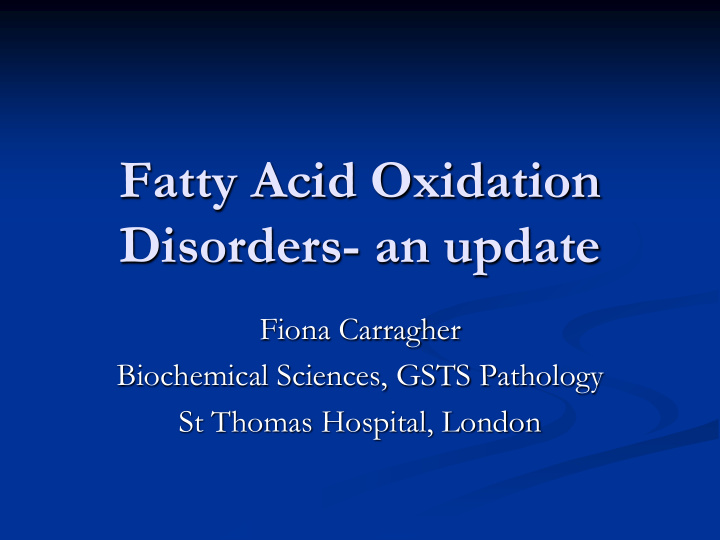



Fatty Acid Oxidation Disorders- an update Fiona Carragher Biochemical Sciences, GSTS Pathology St Thomas Hospital, London
An update…. Overview of metabolism Clinical presentation and outcome Diagnostic approach Monitoring disease progression ACAD 9 SCADD
Fatty Acid Oxidation 1904 Georg Knoop first described B-oxidation Pivotal role in energy homeostasis Gluconeogenesis via production of acetyl-CoA Electrons for respiratory chain Ketogenesis
Regulation of FAO Normal/well fed- glucose preferred substrate Fasting/exercise/illness Adrenaline/NorAdr/Glucagon/ACTH Activate Hormone sensitive lipase Lipolysis induced Release of Free Fatty Acids to feed FAO
Mitochondrial FAO Transport of fatty acids across plasma membrane Fatty Acid Transport Proteins (FATP1-6) Fatty Acid Binding Protein (FABP) Fatty acid Translocase (FAT) Carnitine Shuttle Imports acyl-CoA into mitochondria B-Oxidation Classic 4 enzyme reaction
FAO defects Individually rare, collectively common Typically autosomal recessive Generally episodic symptoms during catabolism Impaired oxidative capacity is overwhelmed Significant morbidity/mortality if undiagnosed
Clinical Presentation Hepatic Presentation Cardiac presentation Severe often lethal Dilated or hypertrophic cardiomyopathy Infancy/neonate Hypoketotic hypoglycaemia Milder/later (adult) Reye-like illness Exercise induced Triggered by catabolic myopathy state rhadomyolysis
Clinical Presentation Major Clinical presentation FAO disorder Fasting hypoketotic hypoglycaemia PCD, CACT, CPT1, CPT II, LCHAD, MCAD, SCAD, MTP, VLCAD, ACAD9 Rhadomyolysis, muscle weakness, myalgia CPT II, VLCAD, ACAD9, LCHAD, MTP Cardiomyopathy PCD, CACT, CPTII, VLCAD, ACAD9, MTP, LCKAT Peripheral neuropathy LCHAD, MTP Maternal HELLP/AFLP LCHAD, MTP
Diagnostic approach (?FAOD) Routine biochemistry Urine organic acids Blood lactate Plasma carnitine and acylcarnitine profile Serum CK Fibroblast culture for enzyme analysis DNA analysis
Long term outcome Prognosis for an individual often uncertain Genotype/phenotype correlation tenuous Far more cases now diagnosed by screening
MCAD deficiency Presents clinically as episodes of hypoketotic hypoglycaemia during catabolic stress Studies pre-screening mortality 16-25% morbidity (intellectual impairment) 20-25% episodes of decompensation >6yr rare No deaths after diagnosis Adult undiagnosed deaths may be underdetected
Now screening is established Australia wide review of outcome Risk of death unscreened cohort 14% (5/35- 2 neonate) Screened cohort 4% (1/24 – neonate) Risk of death in first 72 hr Very little risk post-diagnosis of death with good management 1 patient (unscreened) had mild learning difficulties No other identified problems
Monitoring Evidence based guidelines lacking Clinical monitoring most important Check growth and development Support families re risk of acute episode Control adequacy of treatment Biochemical monitoring less clear Free carnitine to monitor supplementation ? Use of essential fatty acids
Strategies for monitoring
ACAD9- a new disorder Am. J. Hum. Genet. 2007;81:87 – 103. ACAD9 recently recognised (2005) Optimal activity to unsaturated LC-acylcoA (C16:1, C18:1) High degree of homology to VLCAD, but unable to compensate for each other in patients with either deficiency 3 patients described with deficiency in ACAD9 protein
Case Presentation (1) Patient 1 NH3 >700 umol/L 14yr old boy Reye like AST 3355 U/L episode Glu normal Triggered by aspirin Lactate 10.8 mmol/L during mild viral illness CK 2824 U/L Haemodialysis instituted But child unresponsive
Biochemical findings patient 1 Urine Organic Acids Grossly elevated lactate/ketones with dicarboxylic and hydroxydicarboxylic acids, notably 3- hydroxysebacic Liver acylcarnitines increased C18:1 and C18:2 Normal fibroblast B-oxidation studies
Case Presentation (2) Initial presentation 10yr old girl Initially presented fulminant AST >100,000 U/L liver failure 4 months Glu undetectable Responded to IV glu therapy Persistently low platelets Recurrent episodes hepatocellular dysfunction with hypoglycaemia Acute episodes less severe as she has aged
Case (3) 4.5yr girl Cardiomyopathy and dilated left ventricle FH sibling died with cardiomyopathy at 22 months Acute presentation at 18mth severe left ventricular function, hepatomegaly Recurrent episodes of rhadomyolysis with intercurrent illness
Case (3) Glu undetectable during acute illness Plasma Carnitine 67 uM (25-79) Free Carnitine 16.3 uM (21-68) CK during illness >13000 U/L Carnitine supplementation- persistent neuro defects (abnormal gait), muscle weakness and hepatomegaly Died of congestive heart failure 4.5yr
Biochemical findings (2/3) Urine Organic Acids during acute episodes Hypoketotic dicarboxylic aciduria with prominent unsaturated species and 3-hydroxyadipic, 3-OH suberic, 3- OH sebacic Total Carnitine low during illness Fibroblast B-oxidation studies (patient 2 only) Reduced myristate/palmitate oxidation ?defect in long chain FAO
ACAD 9 deficiency Should be considered if other FAOD not identified Challenge to distinguish from other ACADs on basis of metabolites Suggested most likely in unexplained liver failure, cerebellar stroke and cardiomyopathy of unknown origin
SCAD deficiency Biochemical features C4 carnitine Ethylmalonic aciduria Butryl-glycine Butyrate Diagnosis confirmed by DNA analysis
???Clinical relevance Many studies in recent years SCADD generally presents early in life Broad spectrum of clinical presentation Developmental delay Hypotonia Epilepsy Behavioural disorders Hypoglycaemia
But.... Signs and symptoms often disappear Or explained by other causes Individuals diagnosed through sibling studies or newborn screening are asymptomatic Could association of signs/symptoms to SCADD be coincidental?
Comparison of symptoms Incidence of symptoms in metabolically screened patients is comparable to SCADD No specific cluster of clinical signs and symptoms
The implication Diagnosis of SCADD should not preclude a full diagnostic workup for other causes Patients and parents should be informed of potential lack of clinical relevance of SCADD SCADD is not a candidate for Newborn Screening Is SCADD a multifactorial disease
Recommend
More recommend